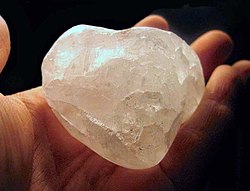Astringent
(Redirected from Astringents)

An astringent is a chemical substance known for its property to shrink or constrict body tissues. The etymology of "astringent" traces back to the Latin word adstringere, which translates to "to bind fast". Notable examples include calamine lotion and witch hazel.
Origin and Perception of Astringency
Astringency is not just limited to the action on tissues but is also recognized as the dry, puckering sensation in the mouth, predominantly due to the presence of tannins. These tannins, which are a subset of polyphenols, have the ability to bind salivary proteins, leading to their precipitation or aggregation[1]. This binding action results in a distinctive dry or "sandpapery" feel in the mouth.
Tannins are naturally found in various fruits, such as:
- Blackthorn (sloe berries)
- Aronia chokeberry
- Chokecherry
- Bird cherry
- Quince
- Persimmon fruits
- Banana skins
Additionally, tannins play a vital role in the taste profiles of some red wines and teas. For instance, young red wines made from grape varieties like cabernet sauvignon and merlot often exhibit a mild astringency.
Uses of Astringents
Astringents have been employed both internally and externally in the field of medicine:
- Internal Use: Astringent medicines are known to cause the shrinkage of mucous membranes or exposed tissues. They can be used to check the discharge of blood serum or mucous secretions, often beneficial in cases such as sore throats, hemorrhages, diarrhea, and peptic ulcers.[2]
- External Use: When applied externally, astringents induce mild coagulation of skin proteins, resulting in the drying, hardening, and protection of the skin[3]. Such properties make them useful in the treatment of:
- Minor skin irritations caused by cuts, allergies, or insect bites
- Fungal infections like athlete's foot
- Acne, especially in those with oily skin
Some frequently used astringent agents encompass:
- Alum
- Oatmeal
- Acacia
- Sage
- Yarrow
- Witch hazel
- Bayberry
- Distilled vinegar
- Cold water
- Rubbing alcohol
There are also astringent preparations which include compounds like silver nitrate, potassium permanganate, zinc oxide, and zinc sulfate. Balaustines, the red rose-like flowers of the pomegranate, have a bitter taste, and their dried form has been traditionally used as an astringent due to their properties[4].
Summary
Astringents, whether natural or synthetic, have a wide range of applications, especially in the medical and cosmetic industries. While they offer several benefits, it is crucial to use them judiciously to avoid any potential side effects.
References
Transform your life with W8MD's budget GLP-1 injections from $125.
W8MD offers a medical weight loss program to lose weight in Philadelphia. Our physician-supervised medical weight loss provides:
- Most insurances accepted or discounted self-pay rates. We will obtain insurance prior authorizations if needed.
- Generic GLP1 weight loss injections from $125 for the starting dose.
- Also offer prescription weight loss medications including Phentermine, Qsymia, Diethylpropion, Contrave etc.
NYC weight loss doctor appointments
Start your NYC weight loss journey today at our NYC medical weight loss and Philadelphia medical weight loss clinics.
- Call 718-946-5500 to lose weight in NYC or for medical weight loss in Philadelphia 215-676-2334.
- Tags:NYC medical weight loss, Philadelphia lose weight Zepbound NYC, Budget GLP1 weight loss injections, Wegovy Philadelphia, Wegovy NYC, Philadelphia medical weight loss, Brookly weight loss and Wegovy NYC
|
WikiMD's Wellness Encyclopedia |
| Let Food Be Thy Medicine Medicine Thy Food - Hippocrates |
Medical Disclaimer: WikiMD is not a substitute for professional medical advice. The information on WikiMD is provided as an information resource only, may be incorrect, outdated or misleading, and is not to be used or relied on for any diagnostic or treatment purposes. Please consult your health care provider before making any healthcare decisions or for guidance about a specific medical condition. WikiMD expressly disclaims responsibility, and shall have no liability, for any damages, loss, injury, or liability whatsoever suffered as a result of your reliance on the information contained in this site. By visiting this site you agree to the foregoing terms and conditions, which may from time to time be changed or supplemented by WikiMD. If you do not agree to the foregoing terms and conditions, you should not enter or use this site. See full disclaimer.
Credits:Most images are courtesy of Wikimedia commons, and templates, categories Wikipedia, licensed under CC BY SA or similar.
Translate this page: - East Asian
中文,
日本,
한국어,
South Asian
हिन्दी,
தமிழ்,
తెలుగు,
Urdu,
ಕನ್ನಡ,
Southeast Asian
Indonesian,
Vietnamese,
Thai,
မြန်မာဘာသာ,
বাংলা
European
español,
Deutsch,
français,
Greek,
português do Brasil,
polski,
română,
русский,
Nederlands,
norsk,
svenska,
suomi,
Italian
Middle Eastern & African
عربى,
Turkish,
Persian,
Hebrew,
Afrikaans,
isiZulu,
Kiswahili,
Other
Bulgarian,
Hungarian,
Czech,
Swedish,
മലയാളം,
मराठी,
ਪੰਜਾਬੀ,
ગુજરાતી,
Portuguese,
Ukrainian
Contributors: Prab R. Tumpati, MD
